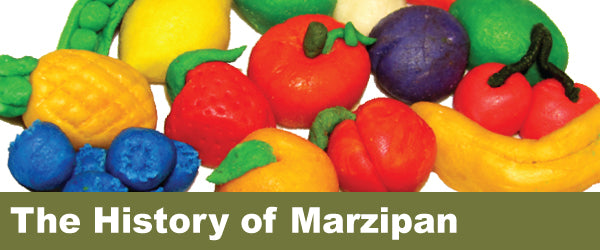
Posted by The Home School in the Woods Team on
Rich in taste and history, marzipan continues to be the sweet almond treat that makes Christmas complete! This shapeable putty made of almonds and confectioners’ sugar is the perfect recipe to add to your history studies this holiday season. Learn more about this delicious almond-flavored dough, its fascinating history, and all the amazing things you can do with it below!
What Is Marzipan?
You may have seen marzipan in the form of realistic-looking candies, or perhaps you’ve marveled at the exquisite marzipan cakes featured on the British Baking Show. Wherever you’ve seen it, marzipan sculptures will leave you in awe!
Made from finely ground blanched almonds, confectioners’ sugar, and sometimes corn syrup and egg whites, marzipan is a soft dough-like mixture that can be shaped into cookies, cake toppings, or tiny figurines. It’s unique in that it acts like playdough and can be used in replacement for fondant.
Once the dough has been made, it can be colored with various dyes and flavored with rose or almond extract to give it a sweet aroma. By using carving tools, you can shape the mixture into anything your heart desires.
When it’s not being disguised under layers of chocolate or flavoring some kind of pastry, you can find it shaped into miniature candies. These candies can surprisingly deceive the eye with details so fine that people often mistake it for the real thing! Fruit and flowers tend to be a popular marzipan candy design with lifelike stems, texture, and ombre tones.
Marzipan as an ingredient can be found in many famous holiday cookie recipes, almond croissants, and of course, New Orleans’s famous “king cakes.” This ingredient is so popular it even has its own holiday with National Marzipan Day on January 12th!
The History of Marzipan
Marzipan is an essential ingredient found throughout baking in Europe, the Middle East, and Latin America. It’s even made its way to many candy shops throughout the United States. But where exactly did this almond and sugar variant originate?
The history of marzipan is unclear, but many believe it can be traced back to 16th-century Italy and Spain. Some even believe it existed well before that, with references to an almond paste in Middle Eastern folk stories.
Marzipan stems from the Latin word martius panis, meaning “sweet pastry of March.” Many legends state that marzipan was invented in Italy during a time when the harvest was unfruitful, and almonds were being added to bread and pizza crusts. The sweet taste inspired them to use almonds in baking, which eventually gave birth to marzipan.
Despite this history, Germans are crowned as the primary makers of marzipan, with their marzipan capital being Lübeck, Germany. Their confectioners are said to use a secret ingredient that makes it some of the highest quality marzipan you can find.
Marzipan continues to be enjoyed throughout the world today, especially in places like Europe. Although marzipan can be enjoyed all year round, it is especially popular around Christmas time and can be a nostalgic treat to many cultures.
If you’re fortunate, you may be able to find this holiday baking ingredient in the store, but if you do, you’ll most likely pay a pretty penny. You can tell the quality of marzipan based on its proportion of almonds and sugar. If the dough uses more almonds than sugar, you’re getting the real deal!
How to Make Marzipan
In light of the price of marzipan, you may want to consider making your own. It’s surprisingly simple and only requires a few ingredients. There are many marzipan recipes out there – from cookies to cakes and candy. Molding marzipan into candies can be a fun event for the whole family. Our kids loved coloring the dough and crafting their own figures during the holidays.
Marzipan can also be a great recipe to accompany your history studies. You could include marzipan if you’re studying the history of Christmas, which you can learn more about in our History of Holidays activity study, or if you’re learning about European culture.

We include marzipan in our Project Passport study on the Middle Ages (a time when marzipan was especially popular). We even include two marzipan recipes: one that calls for store-bought marzipan paste that you can use to make detailed sculpted candies, and the other being a homemade, rustic recipe made from almonds. This recipe is better for simpler sculptures because it’s more grainy.
If you’re wondering, “what does marzipan taste like?” or “will my kids like the taste of marzipan?” then we’re here to tell you it’s delicious! Marzipan has a sweet, nutty taste like no other. As mentioned before, you can flavor it with different extracts like almond, lemon, vanilla, or rose to bring out the sweetness even more.
Although marzipan calls for confectioners’ sugar, it’s primarily made up of almonds, which are full of health benefits that are good for you (...we’ll do anything to convince ourselves that sweets are healthy!).
Add Marzipan to Your Holiday Baking
With the holidays right around the corner, marzipan is the perfect addition to your holiday baking. We hope you and your family enjoy making marzipan as much as ours does and that it becomes a new Christmas tradition in your house. If you happen to make this sweet treat, tag us on Facebook or Instagram so we can see your unique creations!
For more holiday recipes to add to your history lessons, check out our Linzer Cookie Recipe for Valentine’s Day or our St. Patrick’s Day Irish Stew Recipe.
